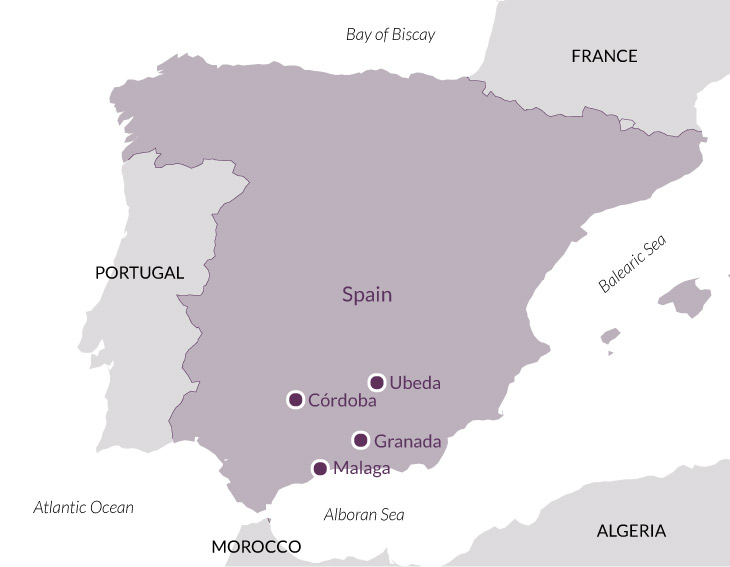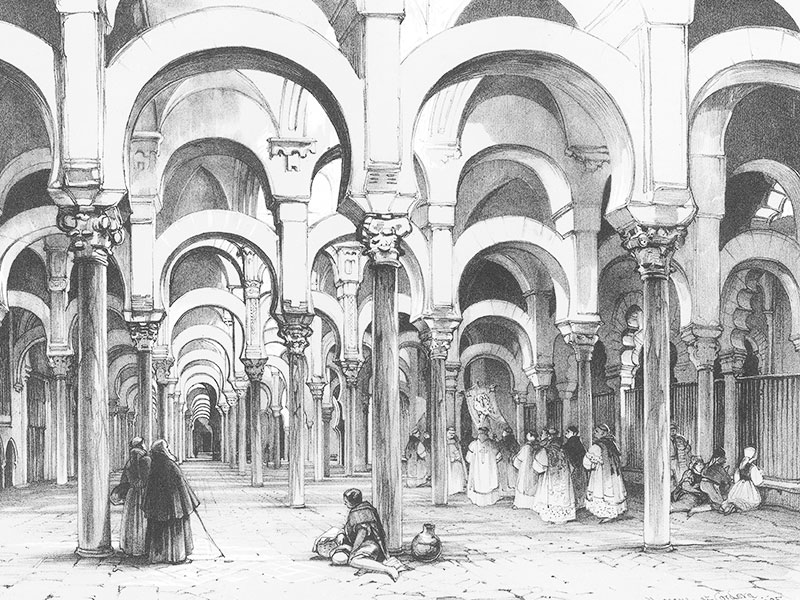Overview
The mythic Al-Andalus, ruled by Islam for more than 750 years, is one of Europe’s greatest examples of the wonders of multi-cultural life. Far north, in the cold mountains of Christian Galicia and its Celt neighbours across the seas we still talk of the Dark Ages, while in Córdoba around the first Millennium the Renaissance had already begun, as the Moors and their protected dhimmi subjects, the Christians and Jews, tested out revolutionary new ideas.
600 years before da Vinci’s inspired doodles of his flying machine, Ibn Firnas had already flown across the hills above Córdoba’s great mosque (admittedly, breaking both legs). In the great city of Córdoba, under the Caliphate, cataract operations were common, mechanical elephants served tea, iced sherbets slaked the thirst, saffron-stained meatballs and the three-course-meal were invented, while the intellect was teased with access to a library that boasted 400,000 books (almost the entire learning of the classical world). Ziryab, Córdoba’s ninth-century tastemaker – the Terence Conran of his time – added the fifth and sixth string to the lute to give its harmony ‘soul’ and provide the guitar.
‘From Caliphs to Kings’ visits the World Heritage protected caves of Granada’s Sacromonte to hear the gypsy wedding ritual, the Zambra. In Úbeda, Spain’s most perfect Renaissance city, Sephardic musicians will bring to life the recently discovered tenth-century Synagogue with its perfectly preserved mikvah – the ritual bath.
From Málaga’s Museo de Picasso, built on 2,500-year-old Phoenician remains, and the wonderful Thyssen Museum – that provides a perfect introduction to the nineteenth-century romantic traveller’s obsession with Carmen and the ‘bandoleros’ – the journey skirts around the Sierra Nevada to Granada’s legendary Alhambra. Home to the Nasrid Kings, the Alhambra’s stage-set beauty is linked by bridge to the glorious vegetable paradise of the Generalife gardens and the royal hunting grounds. Granada is a secret city where composers like Manuel de Falla and the poet Federico García Lorca evoked its beauty within the secrecy of the ‘carmen,’ orange-scented walled garden.
Turn the earth anywhere in Andalucía and ancient cultures come to the fore. The provincial capital of Jaén is built on a rock spur over thousands of acres of olive stands. Hannibal’s elephants crossed this landscape, as too did Caesar’s armies in pursuit of the remnants of Pompey’s battle weary troops.
The tour culminates with Córdoba’s Cathedral and Great Mosque that acts as a compendium of some of the greatest carved columns and capitals from Mesopotamia and the classical world. Here we meet the wisdom of the Jewish philosopher-doctor Maimonides, the luxury and unrivalled power of the Caliph Abd ar-Rahman III and the sheer excess of his successor Al-Hakam at his palace complex of Madinat al-Zahara. Over mint teas and sweet montilla wines, served with deep fried aubergines drizzled with honey in a fourteenth-century convent, we unpick the mysteries of East Andalucía’s glorious past and its fascinating passage ‘From Caliphs to Kings.’
Day 1
Málaga. Fly at c. 9.15am from London City to Málaga (British Airways). Visit Picasso’s birthplace, which houses a small collection of his belongings and some ceramics. First of two nights in Málaga.
Day 2
Málaga. Begin at the Carmen Thyssen museum with its fine collection of old masters and 19th-century Spanish painting. The Picasso Museum is magnificent, combining Phoenician ruins beneath a fine 16th-century palace and a collection which places emphasis on his earlier works and the women in his life. There is time also to see the Renaissance Cathedral with a fine Baroque façade.
Day 3
Granada. Drive north in the morning to Granada. Walk via the Corral del Carbón, the evocative 14th-century caravanserai and silk market, and visit the Casa de los Tiros, Granada’s wonderful ethnographic museum housed in the 16th-century palace of a converted Morisco prince. In the late afternoon visit the Cathedral and Royal Chapel, which retains Isabel of Castile’s personal collection of Flemish, Spanish and Italian paintings. First of three nights in Granada.
Day 4
Granada. The 13th-century Arab palaces of the Alhambra ride high above the city. They are often reckoned to be the greatest expression of Moorish art in Spain, with exquisite decoration and a succession of intimate courtyards. Adjacent are the 16th-century Palace of Charles V and the Generalife, summer palace of the sultans, with gardens and fountains. Evening performance of ‘Zambra’ Flamenco, a gypsy wedding ritual.
Day 5
Granada. Morning walk through the Albayzín, the oldest quarter in town, including El Bañuelo (Arab baths) and the elegant, hispano-moresque gardens of the Instituto de Estudios Arabes. Climb up to San Nicolás from where there are fine views of the Alhambra. The Monasterio de San Jerónimo was the first to be built after the Christian conquest and contains a dazzling altar by Gil de Siloé. There is the option to see the Palacios of the Alhambra in a different light with a late evening visit.
Day 6
Jaén, Úbeda. Silver deposits first attracted the Romans to settle at Jaén before it was taken by the Moors in 712. Its Renaissance cathedral was built on the site of the Great Mosque and designed by outstanding Renaissance architect, Andrés de Vandelvira. See also the 14th-century church of San Ildefonso and the Museo Provincial with a fine archaeological collection. Continue to Úbeda for the first of two nights.
Day 7
Úbeda. In Úbeda walk to the handsome Plaza Vázquez de Molina, flanked by elegant palaces including Vandelvira’s Casa de las Cadenas and the present day parador. The church of El Salvador was designed by Diego de Siloé in 1536 while the 14th-century Casa Mudéjar houses the archaeological museum. Sample some of the famed olive oils of the region at a lunchtime tasting. In the evening visit the 10th-century Sinagoga del Agua with a private performance of Sephardic music.
Day 8
Córdoba. The capital of Islamic Spain from the middle of the 8th century, it became the richest city in Europe until its capitulation to the Reconquistadors in 1236. A morning walk includes the narrow streets of the old Jewish quarter and the 14th-century synagogue. La Mezquita (mosque) is one of the most magnificent of Muslim sites, for some the greatest building of medieval Europe. It contains within it the 16th-century cathedral. First of two nights in Córdoba.
Day 9
Córdoba. Morning visit to the Archaeological Museum, housed in a Renaissance mansion, with a fine collection of Roman and Arab pieces. Visit the Alcázar, medieval with earlier architectural remains (and good Roman mosaics). In the afternoon drive out to the excavations of Medina Azahara, with remains of a huge and luxurious 10th-century palace complex.
Day 10
Drive back to Málaga via the pretty town of Antequera. The flight arrives at London Heathrow at c. 7.15pm.
Price, per person
Two sharing: £3,370 or £3,250 without flights. Single occupancy: £3,830 or £3,710 without flights.
Included
Air travel (economy class) with British Airways (Airbus 320); private coach; accommodation as described below; breakfasts, 2 lunches and 6 dinners with wine, water, coffee; all admissions; all tips for waiters, drivers, guides; all taxes; the services of the lecturer, tour manager and local guides.
Accommodation
Hotel Molina Lario: functional, comfortable 4-star hotel in the centre. NH Collection Granada Victoria: 4-star hotel close to the Royal Chapel; rooms are comfortable and modern. Parador de Úbeda: 4-star parador in a Renaissance palace on the most handsome square in town; comfortable rooms, traditionally furnished. NH Collection Amistad Córdoba: 4-star hotel in a converted 18th-century mansion, a short walk from the mosque. Single rooms are doubles for sole use throughout.
How strenuous?
There is a lot of walking, some of it uphill and some over uneven ground. A good level of fitness is essential. You will be on your feet for lengthy stretches of time. Average distance by coach per day: 36 miles.
Are you fit enough to join the tour?
Group size
Between 10 and 22 participants.
Travel advice
Before booking, please refer to the FCDO website to ensure you are happy with the travel advice for the destination(s) you are visiting.
Combine with
Tintoretto, Titian & Veronese, 26 February–3 March 2024

'The itinerary was cleverly constructed - a narrative - so that by the end of the journey it all came together.'
'Excellent itinerary which was well thought out and integrated. I enjoyed the trip immensely.'
'This was not a gastronomic tour but could have been as the food and meals were so good.'
